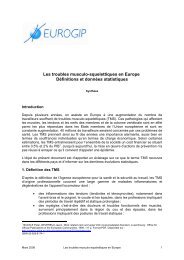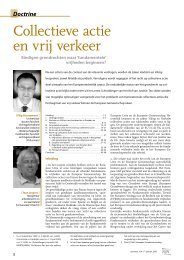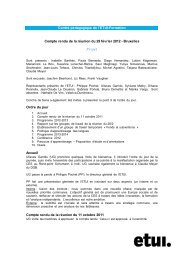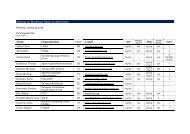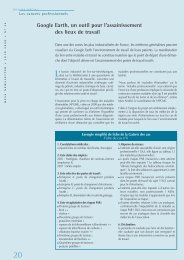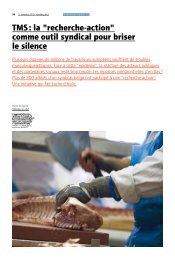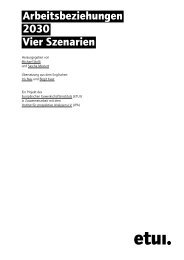Occupation and cancer - European Trade Union Institute (ETUI)
Occupation and cancer - European Trade Union Institute (ETUI)
Occupation and cancer - European Trade Union Institute (ETUI)
Create successful ePaper yourself
Turn your PDF publications into a flip-book with our unique Google optimized e-Paper software.
Acta Oncol Downloaded from informahealthcare.com by 212.35.100.66 on 04/06/11<br />
For personal use only.<br />
686 E. Pukkala et al.<br />
among smelter <strong>and</strong> metal foundry workers (2.11,<br />
1.09 3.68), tobacco manufacture workers, waitresses,<br />
building caretakers <strong>and</strong> cleaners. The lowest<br />
risks were observed among farmers (0.66, 0.57<br />
0.77), teachers <strong>and</strong> those working with religious,<br />
juridical <strong>and</strong> other humanistic work.<br />
Only 59 <strong>and</strong> 57 cases of hemangiosarcoma (http:<br />
//astra.<strong>cancer</strong>.fi/NOCCA/Incidence/liver-hemangio<br />
sarcoma) were diagnosed among men <strong>and</strong> women,<br />
respectively. There were no occupational categories<br />
with significantly elevated risk.<br />
Comment. The occurrence of liver <strong>cancer</strong> is causally<br />
related to the consumption of alcoholic beverages<br />
[67]. Exposure to other known hepatocarcinogens,<br />
Hepatitis B <strong>and</strong> C viruses <strong>and</strong> aflatoxins, is relatively<br />
low in the Nordic countries. High risks can therefore<br />
be expected in occupational categories which, on<br />
the basis of easy availability of alcohol or cultural<br />
traditions, have high alcohol consumption. On the<br />
other h<strong>and</strong>, possible direct occupational factors may<br />
be hidden behind the strong effect of alcohol. Thus,<br />
the risk pattern of men fits well with the image of<br />
high alcohol consumption in various occupations,<br />
whereas chemical factors might contribute to the<br />
highest SIRs in women.<br />
Hemangiosarcoma is associated with occupational<br />
exposure to vinylchloride arsenic, <strong>and</strong> thorotrast, an<br />
X-ray contrast medium used before 1960 [68].<br />
Because of the rarity of both the exposures <strong>and</strong> the<br />
disease, it was not possible see any association<br />
between these factors.<br />
Cancer of the gallbladder <strong>and</strong> biliary tract<br />
The incidence of gallbladder <strong>cancer</strong> was highest in<br />
Denmark around 1975 <strong>and</strong> in Sweden <strong>and</strong> Finl<strong>and</strong><br />
around 1985, while the incidence continues to<br />
/ 100 000<br />
5<br />
4<br />
3<br />
2<br />
1<br />
Denmark<br />
Finl<strong>and</strong><br />
Icel<strong>and</strong><br />
Norway<br />
Sweden<br />
Men<br />
0<br />
1945 1960 1975 1990 2005<br />
/ 100 000<br />
increase in Icel<strong>and</strong> <strong>and</strong> Norway (Figure 23). The<br />
<strong>cancer</strong> has been more frequent in women than in men.<br />
For men, the high risk groups were cooks <strong>and</strong><br />
stewards (SIR 1.56, 95% CI 1.03 2.27), ‘‘other<br />
workers’’ <strong>and</strong> drivers (Table 26). The low risk<br />
groups were farmers (0.75, 0.70 0.80), forestry<br />
workers, gardeners <strong>and</strong> woodworkers. Two groups<br />
of women had a statistically significant but not very<br />
high excess risk of gallbladder <strong>cancer</strong>, these being<br />
building caretakers (1.13, 1.06 1.21) <strong>and</strong> economically<br />
inactive women (mainly housewives). A number<br />
of occupational categories of women had deficit risks<br />
of gallbladder <strong>cancer</strong>. The lowest SIRs were found in<br />
dentists (0.39, 0.14 0.85), nurses, assistant nurses,<br />
<strong>and</strong> teachers (Table 27).<br />
Comment. The presence of gallstones a relatively<br />
common condition, in particular among women aged<br />
50 or more years is associated with a risk of<br />
developing <strong>cancer</strong> of the gallbladder [69]. We have<br />
no information on the prevalence of gallstones over<br />
occupational categories. Body fatness is associated<br />
with increased risk, while no dietary factors have so<br />
far been conclusively linked with risk [70]. Smoking<br />
[71], <strong>and</strong> alcohol consumption [70] do not seem to be<br />
causally linked with the development of gallbladder<br />
<strong>cancer</strong>. The overall impact of occupational exposures<br />
on gallbladder <strong>cancer</strong> is probably very small [69],<br />
although some previous studies found inconsistent<br />
associations with chemical workers, painters, pesticide<br />
manufacturers, vinyl chloride workers, munition<br />
workers exposed to dinitrotoluene, textile workers,<br />
cellulose triacetate fiber manufacturing, workers in<br />
petroleum refining, paper mills, chemical processing,<br />
shoemaking <strong>and</strong> repairing, asbestos related occupations,<br />
<strong>and</strong> exposure to solvents such as methylene<br />
chloride <strong>and</strong> trichlorinated hydrocarbons. Findings<br />
5<br />
4<br />
3<br />
2<br />
1<br />
Denmark<br />
Finl<strong>and</strong><br />
Icel<strong>and</strong><br />
Norway<br />
Sweden<br />
Women<br />
0<br />
1945 1960 1975 1990 2005<br />
Figure 23. Age st<strong>and</strong>ardised (World) incidence rates for <strong>cancer</strong> of the gallbladder 1943 2005, by country <strong>and</strong> gender. Modified from<br />
NORDCAN [49].




